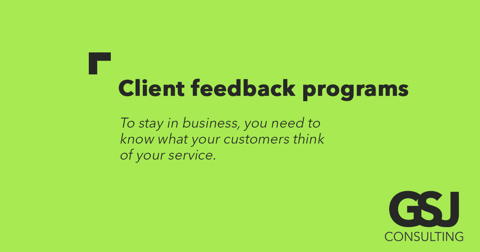5 things to consider when implementing a formal client feedback program

According to the results of a survey undertaken by BTI Consulting Group, 72% of professional services firms’ clients indicated that they want to give feedback on their service provider’s performance. Yet only 30% of firms actually ask their clients for feedback in any meaningful way.
Before moving on, let’s address the phrase “meaningful way”. Many professional services providers would consider and argue that a client paying their invoice counts as “positive feedback” on their performance. However, the reality is that in order to properly bench-test the strength of the relationship you have with your client, you need to implement a robust, formal client feedback program.
What follows are 5 things to consider when implementing a formal client feedback program.
-
What are we trying to achieve with a formal client feedback program?
First off, think about what you are trying to achieve through implementing a client feedback program. It should be fairly obvious – do our customers like us?
But client feedback sessions can actually be a lot more fruitful than that. For example, they are good forums to discuss what is likely to be important to the client over the next 12 months. It’s also a good forum to find out what your competitors are doing better than you.
-
External or in-house?
You need to consider whether to run your client feedback program internally, externally or a hybrid of both. Honestly, there are advantages to both internally and externally, which is why I prefer the hybrid model.
With a program that is run internally, you understand the characters involved, the potential pain-points and the chemistry. An externally run program will be unlikely to have any of these potential benefits. Being one step removed from the process, however, provides a level of independence that clients often like. It frees them up to be more honest with their feedback.
Having a hybrid program, where the program is:
-
-
run in-house;
-
but interviews done either by an external consultant or an external consultant with someone from in-house who isn’t associated with the client account,
-
has, in our experience, been the best approach to take as you capture the best of both approaches.
Either way, you should decide at the outset which approach you want to take and then follow that approach going forward to be consistent.
-
How do we get the feedback we need?
There are several ways you can client feedback.
One of the most popular ways is client interviews with a Q&A component. These are popular because they add a personal element to the process. Here you can do the interview over the phone/Teams/Zoom – which became popular during COVID, or by visiting the client’s office (assuming they are not in a totally different geographic location/city).
Another way to get the feedback you need is to email the questionnaire to the client. This format follows the Net Promoter Score methodology but typically is a little bit more robust, in that it has more detailed and specific questions.
This type of feedback approach is popular when seeking feedback on specific matters, whereas the interview approach is more popular when seeking feedback on the relationship overall.
-
Who do we need to be asking when seeking meaningful client feedback?
The purpose of client feedback sessions is to learn how the customer experienced the delivery of your services and to identify improvements for future engagements. As such, you need to be asking questions like:
-
-
What did we do well?
-
What did we not do well?
-
Were we responsive enough?
-
How could we have improved the experience?
-
Did you feel the team worked well together to get you the result you wanted?
-
And if it is a relationship interview, you should add questions about whether they are happy with the performance of the relationship partner? Are there things your competitors are doing better?
-
How do we act on the feedback?
Lastly, how you act on the feedback given to you is critical.
If you ask for feedback and get some tough comments and then don’t put in place a program to address and/or rectify that, then you are asking for trouble. As the saying goes, “If you won’t like the answer, don’t ask the question!”
At the end of the day, to stay in business, you need to know what your customers think of your service. Implementing a formal client feedback program will help you to alleviate a lot of these issues.
Contact GSJ Consulting
We can help you Aquire, Retain, Grow
The information contained in this article is of general nature and should not be construed as professional advice. If you require further information, advice or assistance for your specific circumstances, please contact us.
